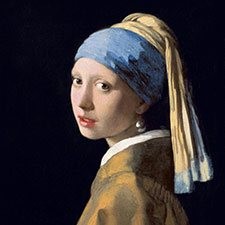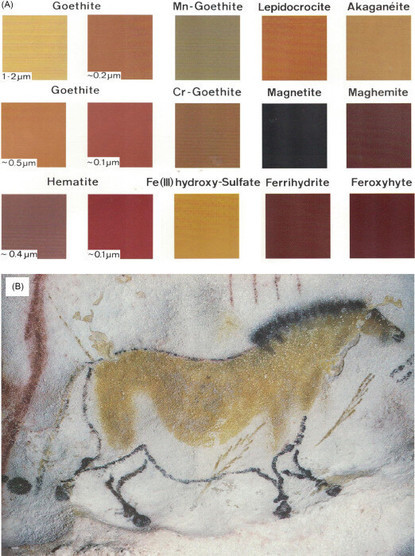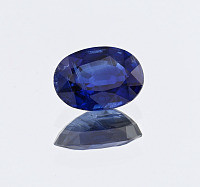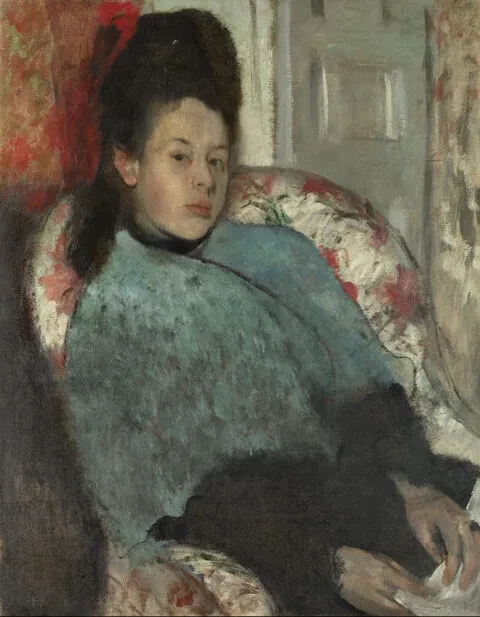Though kyanite is used in the arts, hematite is the most important pigment left standing, & vital to millennia of art history so easily wins the art vote. Red ochre, earth, Venetian red, mars red & English red. A stable, rich, vibrant red in cave paintings through contemporary paintings! #MinCup25
Vote for hematite here: https://www.mineralcup.org/2025/vote/r4m01

Johannes Vermeer, Girl With a Pearl Earring
ca 1665
Medium: Oil
Support: Canvas
Size: 44.5 cm x 39 cm
Art period: Baroque
Mauritshuis, The Hague
Painting
This is the famous painting of the young Dutch woman in gold jacket with white collar, gold and blue turban with large pearl earrings looking over her shoulder at the viewer, against a near-black background.
“Vermeer, Girl with a Pearl Earring is an exceptional example of Vermeer’s genius, it is a portrait of an unknown girl or maybe a generalized female head (called a ‘tronie’ in Netherlands). The pigment analysis revealed a limited palette consisting of red, brown and yellow ochre, natural ultramarine, indigo, lead white, and the rare yellow pigment weld (luteoline).”
Red ochre is hematite.
Via ColourLex

An image of a cave painting and analysis of pigments used. There’s a rotund beige horse outlined in black from the Lascaux caves, and a collection of squares of browns and black labelled with the mineral pigment used to produce these colours at Lascaux. 6 squares are due to Goethite in umbers and browns. 2 dark browns from Hematite. Black from magnetite. 5 brown squares from: Lepidocrocite, Akaganeite, Maghemite, Feroxyhyte, Ferrihydrite and Fe(III) hydroxy-Sulfate.

Kyanite is a naturally occurring aluminum silicate mineral that typically forms as bladed crystals, and occasionally it occurs as radiating masses of crystals. The name kyanite is derived from the Greek word kyanos which means “blue.” Gem quality kyanite has a royal blue color similar to fine sapphire. This material is highly prized by those who cut gemstones. Kyanite can be cut en cabochon, faceted, or fashioned into beads, however its variability in hardness and color zoning can make it difficult to fashion and facet. Transparent intense blue kyanite is beautiful and is considered to be an exotic gemstone because it is not often seen in jewelry. Kyanite is predominately found in shades of blue and green, but it can also be yellow, white and orange. This 5.87ct gem is an intense deep blue color and the largest and finest kyanite from Nepal in the National Gem Collection. Smithsonian Museum"

Edgar Degas, Portrait of Elena Carafa
ca 1875
Medium: oil
Support: canvas
Size: 70,1 x 55 cm
Art movements: Impressionism, Realism
National Gallery London
NG4167
“The sitter for this portrait, Elena Carafa, was Degas’ first cousin, who lived with her sister Camilla and their mother Stefanina, Duchess Montejasi-Cicerale, in Naples.
The portrait of Elena Carafa by Edgar Degas shows an assured young lady” wearing a black dress and blue shawl, seated back in a floral armchair with red floral wallpaper and white door behind her. She has dark brown hair piled high on her head and looks at the viewer with her chin forward like she’s daring you to judge her.
Uses red ochre (hematite) as a pigment
